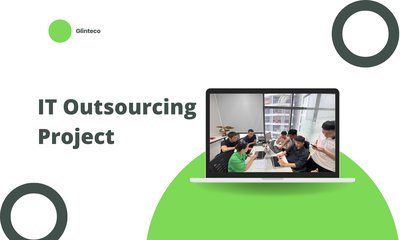Types of IT Outsourcing Services: A walkthrough with Glinteco
By khoanc, at: Jan. 9, 2024, 4:50 p.m.
Estimated Reading Time: __READING_TIME__ minutes


Types of IT Outsourcing Services: A walkthrough with Glinteco
These days, businesses are increasingly relying on IT outsourcing services to improve their capabilities, reduce costs, and stay competitive. But with so many options available, it can be challenging to understand which type of outsourcing service is right for your organization.
In this blog post, we will go through some types of IT outsourcing services, providing real-world examples and insights to help you make an informed decision.
Onshore Outsourcing
What is Onshore Outsourcing?
Onshore outsourcing involves contracting an external service provider located in the same country/city as your business. This type of outsourcing can be beneficial for companies that prefer minimal time zone differences and cultural similarities.
Pros
- Minimal Time Zone Differences: Easier coordination and communication due to similar working hours.
- Cultural Similarities: Fewer misunderstandings and smoother collaboration.
- High Quality Standards: Often adheres to the same quality and regulatory standards as your business.
- Quick Resolution: Faster problem-solving and troubleshooting due to geographical proximity.
Cons
- Higher Costs: Typically more expensive than nearshore or offshore options.
- Limited Talent Pool: Smaller pool of available experts compared to global options.
- Less Flexibility: May offer less flexibility in terms of scaling up or down quickly.
- Potential Competition: Providers may also serve your competitors, leading to potential conflicts of interest.
Example
A financial services company in New York might outsource its IT support to a managed service provider in California to ensure seamless communication and coordination.
as Glinteco is currently working with some local companies in Hanoi due to their resource limitation.
Nearshore Outsourcing
What is Nearshore Outsourcing?
Nearshore outsourcing refers to contracting services from neighboring or nearby countries. This approach offers a balance between cost savings and reduced time zone differences, making collaboration more efficient.
Pros
- Cost-Effective: Generally more affordable than onshore outsourcing while still offering significant savings.
- Proximity: Closer geographical location means smaller time zone differences, facilitating easier communication.
- Cultural Affinity: Greater cultural and business practice similarities compared to offshore outsourcing.
- Skilled Workforce: Access to a diverse talent pool with high levels of expertise and education.
Cons
- Moderate Cost: Can be more expensive than offshore outsourcing.
- Language Barriers: Potential language differences, though often less pronounced than with offshore outsourcing.
- Travel Costs: Still involves travel expenses, although lower than with offshore destinations.
- Political and Economic Stability: May be subject to different political and economic conditions, impacting business operations.
Example
A tech startup in Germany might choose to outsource software development to a team in Poland, benefiting from both cost efficiency and geographical proximity.
This happens a lot between Japan and Vietnam companies
Offshore Outsourcing
What is Offshore Outsourcing?
Offshore outsourcing involves contracting services from distant countries, often to take advantage of lower labor costs. While it can offer significant cost savings, it also requires careful management of communication and time zone differences.
Pros
- Significant Cost Savings: Often the most affordable option due to lower labor costs in the outsourcing country.
- Access to Global Talent: Provides access to a vast and diverse pool of skilled professionals.
- 24/7 Operations: Different time zones can enable round-the-clock operations and support.
- Scalability: Easy to scale operations up or down based on project requirements.
Cons
- Communication Challenges: Time zone differences and language barriers can hinder effective communication.
- Cultural Differences: Potential for misunderstandings due to differing business practices and cultural norms.
- Quality Control: Varying standards and practices can impact the quality of work.
- Security Risks: Increased risk of data breaches and intellectual property theft due to regulatory differences.
- Longer Response Times: Delays in addressing issues due to geographical and time differences.
Example
A US-based e-commerce company might outsource its customer support to a call center in India to reduce operational costs while maintaining 24/7 service availability.
IT Staff Augmentation
What is IT Staff Augmentation?
IT staff augmentation involves hiring external IT professionals to work alongside your in-house team on specific projects. This type of outsourcing is ideal for businesses that need to quickly scale their workforce for short-term projects. There is always a risk of low-authority/ownership, which might lead to quality issues.
Pros
- Flexibility: Allows you to quickly scale your team up or down based on project needs.
- Access to Expertise: Provides access to specialized skills and expertise that may not be available in-house.
- Cost-Efficiency: Reduces the costs associated with hiring full-time employees, such as benefits and long-term commitments.
- Control: Maintains direct control over the augmented staff and their tasks, ensuring alignment with your company's processes and goals.
- Speed: Accelerates project timelines by bringing in additional resources to meet deadlines.
Cons
- Integration Challenges: Temporary staff may face difficulties integrating with your existing team and company culture.
- Training Time: Requires time and effort to onboard and train augmented staff to understand your specific processes and tools.
- Management Overhead: Increases the burden on your managers to oversee and coordinate with the augmented staff.
- Variable Quality: The quality of work may vary depending on the external staff's skills and experience.
- Dependency: Creates a potential dependency on external staff for critical projects, which can be risky if they leave before project completion.
Example
A healthcare provider may need to augment its IT team with cybersecurity experts to implement a new security system within a tight deadline.

Managed IT Services
What are Managed IT Services?
Managed IT services involve outsourcing the management and maintenance of your IT infrastructure to a third-party provider. This allows businesses to focus on their core operations while the service provider handles everything from network monitoring to data backup.
Pros
- Cost Savings: Reduces the need for in-house IT staff, lowering labor costs and overhead expenses.
- Expertise and Experience: Provides access to a team of IT professionals with diverse skills and up-to-date knowledge.
- Proactive Maintenance: Offers continuous monitoring and proactive maintenance to prevent issues before they impact your business.
- Scalability: Easily scales services up or down based on your business needs and growth.
- Focus on Core Business: Allows your team to focus on core business activities while the managed service provider handles IT operations.
- Enhanced Security: Provides advanced security measures and compliance with industry standards to protect your data and systems.
Cons
- Loss of Control: Relinquishes some control over IT operations to an external provider, which can be a concern for some businesses.
- Dependency: Creates dependency on the service provider for critical IT functions, which can be risky if the provider experiences issues.
- Communication Challenges: Potential for miscommunication or delays in response times due to external management.
- Customization Limits: May offer limited customization options compared to an in-house IT team that fully understands your specific needs.
- Initial Transition: Requires time and effort to transition IT operations to the managed service provider and align processes.
Example
A retail chain might partner with a managed IT service provider to ensure its point-of-sale systems are always up and running smoothly.
Cloud Services
What are Cloud Services?
Cloud services outsourcing involves leveraging third-party cloud providers for data storage, software applications, and computing power. This type of outsourcing can offer scalability, flexibility, and cost savings.
Pros
- Scalability: Easily scale resources up or down based on demand, ensuring optimal performance and cost-efficiency.
- Cost Savings: Reduces the need for physical hardware and maintenance, lowering capital expenditure and operational costs.
- Accessibility: Provides access to data and applications from anywhere with an internet connection, enhancing flexibility and remote work capabilities.
- Disaster Recovery: Offers robust disaster recovery solutions with automatic backups and data redundancy.
- Automatic Updates: Ensures that software and systems are always up-to-date with the latest features and security patches.
- Collaboration: Facilitates seamless collaboration through shared tools and resources, improving team productivity.
Cons
- Security Concerns: Potential risks related to data breaches and loss of control over sensitive information.
- Downtime Risks: Dependent on the reliability of the cloud service provider, with potential risks of downtime or service interruptions.
- Compliance Issues: May face challenges with regulatory compliance and data sovereignty, especially for businesses in highly regulated industries.
- Limited Customization: Standardized services may offer limited customization options compared to on-premises solutions tailored to specific needs.
- Internet Dependency: Requires a stable and fast internet connection for optimal performance, which can be a limitation in areas with poor connectivity.
- Hidden Costs: Potential for hidden costs related to data transfer, storage, and additional services, which can add up over time.
Example
A media company might use cloud services to store and manage its vast library of digital content, ensuring quick and reliable access for its users.
Business Process Outsourcing (BPO)
What is Business Process Outsourcing?
BPO involves outsourcing specific business processes, such as payroll, HR, or accounting, to specialized service providers. This allows companies to streamline operations and focus on their core competencies.
Pros
- Cost Savings: Significantly reduces operational costs by leveraging lower labor costs in outsourcing locations.
- Focus on Core Activities: Allows businesses to concentrate on their core competencies while outsourcing non-core functions.
- Access to Expertise: Provides access to specialized skills and expertise that may not be available in-house.
- Scalability: Offers flexibility to scale operations up or down based on business needs and market conditions.
- Improved Efficiency: Enhances process efficiency and productivity through streamlined operations and best practices.
- Risk Management: Shares risks with the BPO provider, particularly in areas such as compliance and regulatory requirements.
Cons
- Loss of Control: Relinquishes some control over outsourced processes, which can lead to concerns about quality and consistency.
- Communication Barriers: Potential for communication challenges due to language differences and time zone variations.
- Security Risks: Increases the risk of data breaches and loss of confidential information, requiring stringent security measures.
- Cultural Differences: May encounter cultural differences that impact working relationships and business practices.
- Dependency on Provider: Creates dependency on the BPO provider, making it difficult to switch providers or bring processes back in-house.
- Potential Quality Issues: Varying levels of service quality and performance depending on the provider's capabilities and resources.
Example
A small business might outsource its payroll processing to a BPO provider, ensuring accurate and timely payroll management without the need for an in-house payroll department.
Conclusion
Understanding the different types of IT outsourcing services is A MUST for making the right choice for your business. By evaluating your specific requirements and considering the examples provided carefully, you can make a more informed decision and leverage the power of IT outsourcing to drive your business forward.
At Glinteco, we offer a range of managed IT services designed to help businesses thrive in today's competitive landscape. From 24/7 monitoring and support to software development and AI/machine learning programs, our expert team is here to support your IT needs. Contact us today to learn more about how we can help your business succeed.





